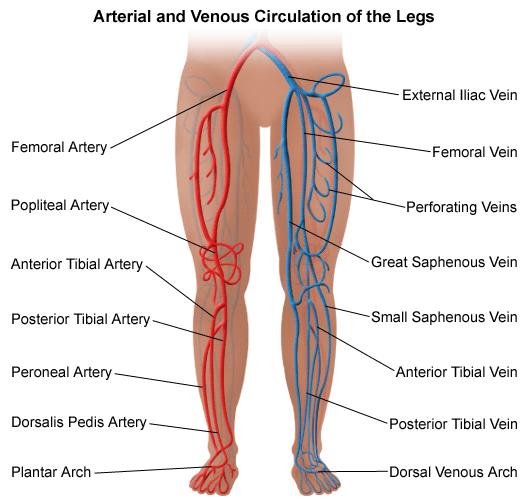Varicose veins are enlarged, twisted veins. Varicose veins can happen anywhere in the body, but are more common in the legs.
Varicose veins are not considered a serious medical condition. But, they can be uncomfortable and can lead to more serious problems. And, because they may be very noticeable, they may cause people to feel uncomfortable or embarrassed.
What are spider veins?
Spider veins, a milder type of varicose veins, are smaller than varicose veins and often look like a sunburst or "spider web." They are red or blue in color and are commonly found on the face and legs, just under the skin.
What is the main cause of varicose veins?
Varicose veins are caused by increased blood pressure in the veins. Varicose veins happen in the veins near the surface of the skin (superficial).
The blood moves towards the heart by one-way valves in the veins. When the valves become weakened or damaged, blood can collect in the veins. This causes the veins to become enlarged. Sitting or standing for long periods can cause blood to pool in the leg veins, increasing the pressure within the veins. The veins can stretch from the increased pressure. This may weaken the walls of the veins and damage the valves.
Can you get rid of varicose veins?
Treatment for varicose veins may include self-care measures, compression stockings, and surgeries or procedures. Procedures to treat varicose veins are often done as an outpatient procedure, which means you usually go home on the same day.
What is the best treatment for varicose veins?
Larger varicose veins are generally treated with ligation and stripping, laser treatment, or radiofrequency treatment. In some cases, a combination of treatments may work best. Smaller varicose veins and spider veins are usually treated with sclerotherapy or laser therapy on your skin.
What happens if varicose veins are left untreated?
If left untreated, varicose veins usually result in excess blood leaking into the tissues of the leg. The patient will experience painful swelling and inflammation as parts of their skin become dark and discolored. This condition is known ashyperpigmentation.
How can I stop varicose veins getting worse?
- Exercise regularly. Your leg muscles are your biggest allies. ...
- Lose weight if you're overweight. ...
- Avoid standing or sitting for a long time. ...
- Don't wear tight-fitting clothes. ...
- Be sure to put your feet up. ...
- Wear support pantyhose. ...
- Invest in a compression hose
Medical treatment may not be necessary if there are no symptoms. However, varicose veins may sometimes worsen without treatment.
Medical treatment may include:
Elevation of the legs. You may be instructed to elevate your feet above the level of your heart 3 or 4 times a day for about 15 minutes at a time. If you need to sit or stand for a long period of time, flexing (bending) your legs occasionally can help keep blood circulating. If you have mild to moderate varicose veins, elevating your legs can help reduce leg swelling and relieve other symptoms.
Compression stockings. These elastic stockings squeeze the veins and prevent blood from pooling. Compression stockings can be effective if they are worn every day.
Sclerotherapy. Sclerotherapy is the most common treatment for both spider and varicose veins. A salt (saline) or chemical solution is injected into the varicose veins. They no longer carry blood. And, other veins take over.
Thermal ablation. Lasers or radiofrequency energy may be used to treat varicose veins. A tiny fiber is inserted into a varicose vein through a catheter. The laser or radiofrequency energy is used to deliver heat that destroys the wall of the varicose vein.
Vein stripping. This is surgery to remove varicose veins.
Microphlebectomy. Special tools inserted through small cuts (incisions) are used to remove varicose veins. It may be done alone or with vein stripping.
Post time: Jul-18-2022

